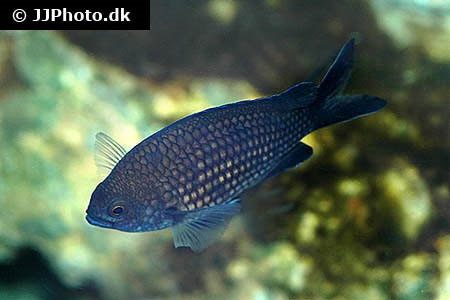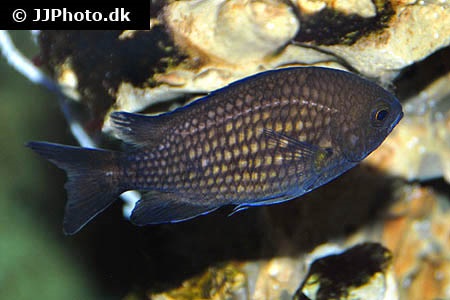Chromis chromis


| Latin name | Chromis chromis |
|---|---|
| Local name | Damselfish |
| Family | Pomacentridae - Chromis |
| Origin | West Indian Ocean, Mediterranean Sea |
| Max length | 25 cm (9.8") |
| Minimum volume |
l ( gal) |
|---|---|
| Hardiness |
Average |
| Suitable for aquarium |
Unknown |
| Reef safe |
Always reef safe |
| Aggressiveness | Unknown |
| Recommended |
Small crustaceans (Krill, mysis, artemia...) Zooplankton (Cyclops, pods...) |
|---|
There is little available knowledge of this species, so there can be important information missing on this page.
Chromis are often seen in large shoals in the fish store, but note that they might stop shoaling when sexually mature. When they are mature, they will become more aggressive towards each other. If a larger shoal can be kept, the aggression can then be directed towards several individuals, thus increasing the chances of success.
But in comparison to the other species in this family, the chromis are reasonably peaceful.
Clown-/Damselfish (Pomacentridae) can be divided into three groups as described below.
Clown-/Anemonefish (Amphiprioninae) are characterised in that they spend most of their time in an anemone. They can be kept outside of one and sometimes will find another coral to hide in. This can be Hammercoral, Xenia or similar. Clownfish exhibit fascinating social behaviour, especially when carrying eggs. This is even more interesting when kept with an anemone or a substitute.
They go normally in pairs and most are easy to keep in aquaria. Clownfish can easily be kept in small tanks, as they do not swim around a lot.
It is important to have a male and female or two males to one female, as two females do not tolerate each other. When one acquires two fish of very different size or two small individuals, it is likely they will become a pair.
When setting up a reef aquarium, Clownfish are the obvious choice. They can be aggressive towards other kinds of fish, but mainly when these get too close to their hiding place. They do tend to get more aggressive when they have an anemone or when carrying eggs.
Most of Clownfish are of the Amphiprion genus, but there is a single species in the Premnas genus.
Chromis (Chrominae) encompass the genera, Acanthochromis, Altrichthys, Chromis, Azurina and Dascyllus, but when talking about Chromis it is normally understood to mean the fish of the Chromis genus specifically.
Fish in the Chromis genus are not as hardy as the Clown or Damselfish, but are very attractive with their shiny blue and green colour nuances. Overall the fish in this group are less aggressive than many others in this family and are often seen in shoals. They do become more aggressive when pairing or laying eggs.
Fish in this group live mainly on zooplankton and must be fed frequently, if possible several times a day.
Some in this group are often seen hiding in stony corals e.g. Acropora, but some species may look for shelter in anemones.
Damselfish (Pomacentrinae and Lepidozyginae) are typically hardy, very attractive, but very territorial. Some species are very coulorful when young, but become dull over time.
They live typically of a mixture of zooplankton and algae, some live more on algae and some on zooplankton. Some Damselfish even cultivate their preferred algae in a small "garden", so they have their own foodsource. This does explain their aggression towards other fish and invertebrates, which want to eat their algae.
Because of their territorial behaviour it is best to keep only one Damselfish per aquarium, unless it is a very large tank. One should consider not acquiring Damselfish, if at a later stage very peaceful or docile fish will be kept, as it is almost impossible to catch them, without removing rocks from the tank. Sometimes it is possible to entice them to hide somewhere, where they can be caught, i.e. a hollow stone. In a large aquarium where a Damselfish has its own territorium, this is a much smaller problem.
Damsels are placed in the genera; Abudefduf, Amblyglyphidodon, Amblypomacentrus, Cheiloprion, Chrysiptera, Dischistodus, Hemiglyphidodon, Hypsypops, Lepidozygus, Mecaenichthys, Microspathodon, Neoglyphidodon, Neopomacentrus, Nexilosus, Parma, Plectroglyphidodon, Pomacentrus, Pomachromis, Pristotis, Similiparma, Stegastes and Teixeirichthys.
Tea Yi Kai. 2014. Reef Nuggets 1: Damsels in disguise - Reef Builders - (English)
Henry C. Schultz. 2003. Friendly Damsels? It Can't be Possible!… The Genus Chromis - Reefkeeping Magazine - (English)
Scott W. Michael. 2008. Damselfishes & Anemonefishes (Reef Fishes) - TFH Publications / Microcosm Ltd. - (English)
James W. Fatherree. 2011. Aquarium Fish: Damselfishes and Chromises: the Good and the Bad - Advanced Aquarist - (English)
Bob Fenner. The Damsel and Anemonefishes, Family Pomacentridae - Wet Web Media - (English)

